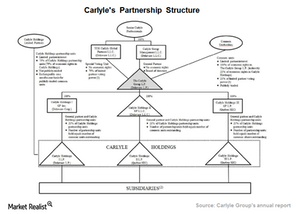Understanding the Carlyle Group Partnership Structure
The Carlyle Group (CG) raises funds and investment commitments using a partnership structure, also known as an investment vehicle.
Sept. 24 2015, Published 3:51 p.m. ET

Partnership structure
The Carlyle Group (CG) raises funds and investment commitments using a partnership structure, also known as an investment vehicle. The investors or commitment holders in these partnership structures or funds are known as limited partners. The limited partners subscribe to these investment vehicles by committing the funds required as per a mandate of designated fund. Commitments are drawn down whenever the company has to fund an investment, acquisition, or buyout over a specified term. Limited partners don’t take part in the operation or control of Carlyle’s investment funds.
The Carlyle Group LP holds, through its subsidiaries, a number of Carlyle Holdings partnership units.
Who manages investment funds?
The investment funds or partnership structures, separately managed accounts, and other structured vehicles are generally advised by the Carlyle entity—Carlyle Group Management LLC. It serves as an investment adviser or general partner.
A partnership structure or investment fund also has general partners that make investments and operational decisions relating to the conduct of the fund’s business. General partners are typically the managing directors in a private equity firm. They make decisions related to making, monitoring, and disposing of investments. They have the authority to act for the investment funds in terms of raising, deploying, and liquidating funds.
Capital contributed by general partners
General partners, to reflect their interest in management, commit capital to investment funds. They typically don’t commit more than 9% of the total commitments in an investment fund. Limited partners contribute at least 91% of the total commitments.
The general partners’ strong network demonstrates the firm’s investment managing capabilities.
